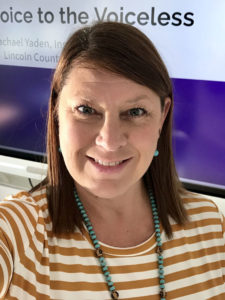
Rachael Yaden
With professional development money seemingly dwindling every year, educators are finding it harder and harder to learn new and innovative ways to teach America’s past and help students connect with it. While we know how to teach the flawed pantheon of historical figures, many of our students fail to see someone who looks or thinks like them.
It is more important than ever for our students see themselves in America’s diverse past. A recent experience with the George Washington Teacher Institute (GWTI) allowed me to explore a more inclusive narrative of our nation’s history and forever altered my instructional view.
When I reflected upon creating a more inclusive curriculum, I knew I must redefine how students understood historical “truth.” There are four truths in every narrative: forensic (fact-based), personal (feeling- or experienced-based), social (“we tell … because we have to …”) and reconciliatory (steps against an injustice). These truths allow students to look beyond measurable facts and details and allows learners to interact with history with their emotions, connect with their own experiences and explore how people perceive injustices and subsequent actions.
Personal truth is powerful and heavy, but it also gives credence to history. Educators must provide a brave space for this kind of classroom dialogue – a space where honesty, hurt and healing can all co-exist with dignity and respect. By creating a brave space grounded in the four truths, we can help our students get past a singular story and realize it’s “we” not “me.”
When we teach about the experiences of the enslaved, we must remember that the institution of slavery was about families. We must humanize those who were bound to the institution. Teach about the people, not just their actions or as causes for another event. Allow your students to get to know these early Americans through primary source documents.
During my work at the George Washington Teacher’s Institute, I brought Penny’s story to light. Penny was one of Washington’s enslaved people and the only record is found in Washington’s 1799 census. She was 11. As I pieced together research from Mount Vernon’s enslaved biographies, I discovered a deeper story. Through Washington’s own daily journal recording and ledgers, I discovered that Penny’s mother ran away at least three times. How would that affect a young girl? How would that affect her family?
We also know from Washington’s will that Penny’s mother and siblings were freed upon Martha Washington’s death, but her father wasn’t. Based upon the laws of the day against women and former enslaved people, the same questions came to mind. In the blink on an eye, Penny’s reality shifted and new challenges arose, just like many of our students. How many of our students could relate in some part to Penny’s story?
By focusing upon those marginalized by traditional history – like Penny and her family – we can provide a more balanced historical narrative. While it is often difficult to find and curate sources that ground the enslaved voice, most enslaver historic sites now dedicate portions of their websites to sharing the narratives of those enslaved. Other websites that have resources include C3 Teachers and The Reckoning.
One lesson idea is to explore historical portraits, but through the lens of the enslaved person or persons who prepared that person for the sitting. Name these men and women and talk about their role in the paintings.
Another lesson idea is to focus upon choices; create a primary source-based lesson with the enslaved as the main actors. While exploring different runaway advertisements, create teams to analyze each advertisement. Instruct students to respond to two guiding questions:
- What’s the “meat” of the document? This is not a summary of the advertisement. This is making inferences – based upon evidence – about the individual in the advertisement, about appearance, skills and any interesting tidbits revealed. This allows students to get to know the person and not the institution of slavery.
- How the family unit is impacted. What could the family unit response have been? This allows students to empathize without role-playing. They can draw upon their own experiences and connections, but they are not asked to put themselves into an enslaved person’s shoes.
While this lesson focuses upon those who chose to run, it also can lead to discussions surrounding those who chose not to run. Students can explore the different kinds of resistance and perseverance in which the enslaved people participated. End with an individual reflection of the possible effects running might have had on the family. By creating a lesson around human choice, you will give both voice and agency to those often overlooked. This lesson could also work with the indigenous people of America and the Trail of Tears, as well as Women’s Suffrage.
By adding voice to those often marginalized in history, we provide our students with a fuller, more truthful and more inclusive view of our nation’s past. We must remember that our history, our collective history, is made up of men, women and children of every background and all deserve equal time in our past’s narrative.
Rachael Yaden is an instructional coach at Lincoln County High School. She was one of the writers of the 2019 Kentucky Academic Standards for Social Studies and is currently serving on the Executive Committee for the Kentucky Council for the Social Studies. Before her transition to instructional coaching, Yaden taught both 7th- and 8th-grade social studies over the course of 12 years. For more information about the George Washington Teacher Institute, please feel free to email the author or gwti@mountvernon.org. Use this Google doc for an additional list of websites you can use to increase your inclusiveness.




Leave A Comment